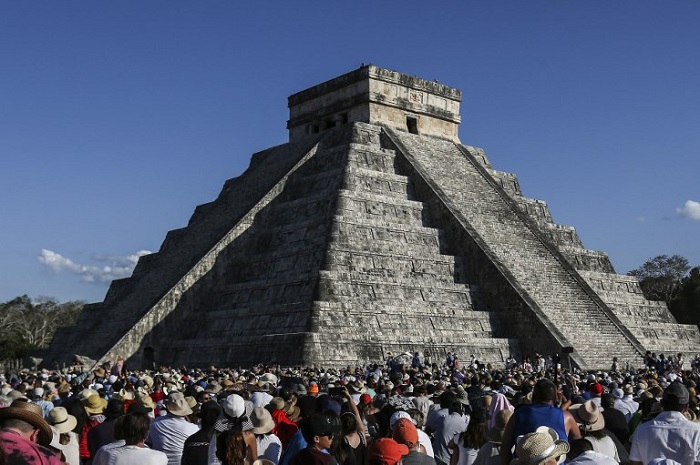Next Sunday the 20th, a double archaeoastronomical phenomenon will be visible in Chichén Itzá, starring the Sun and Venus, which will be observed in El Castillo and El Observatorio – Caracol informed the Yucatecan astronomer Eddie Ariel Salazar Gamboa.
Along with the vernal equinox, that day the maximum elongation of Venus will be recorded, both events were of great relevance to the Maya priest-astronomers.
Salazar Gamboa highlighted the knowledge that this civilization developed, since they are events of great precision, with the difference that the descent of Kukulcán on the northwest truss of El Castillo is a massive event, while in the case of the Caracol, it was only for the priest-astronomers and/or rulers to observe.
“In all the ceremonial centers of the various cultures of the world, the Sun was venerated, since they are sacred places, and the Maya were no exception,” said the academic from the Technological Institute of Merida (ITM).
For the pre-Hispanic Maya, Kin was the god of the Sun, while Noh Ek was the deity of the planet.
He announced that next Sunday, March 20th, the spring equinox will take place, whose days will be equal in the countries that are on the terrestrial equator.
Although by tradition it is reported that the beginning of spring occurs on March 21, but for 50 years this astronomical phenomenon no longer falls precisely on that date, and, since 1972 it is recorded on the 20th, and only in leap years will it happen the 19th.
The professor emeritus of the Autonomous University of Yucatan (UADY) explained that due to the astronomical phenomenon of the precession of the equinoxes, each year there is a delay that influences the start day of this event.
He mentioned that at 3:33 am “it is the exact moment in which the cut with the vernal point of intersection of the ecliptic with the celestial equator will be recorded”.
At the spring equinox, the Sun has a longitude of zero degrees with respect to the north, that is, it will be seen to rise exactly from the east when the displacement of the Sun coincides with the celestial vault.
Gamboa Salazar indicated that from the archaeoastronomical point of view, the Sun played an important role for the Maya, and many of the buildings of various pre-Columbian cities report some sort of alignment to it.
Therefore, the archaeoastronomical phenomenon of the spring equinox will be seen with greater precision from this date, due to the geographical location of the Peninsula and the deviation of the buildings that mark these events.
The coordinator of the Astronomy Group “Hipatia de Alejandría” of the ITM remarked that from the astronomical point of view, the equality of day and night will not happen for Yucatan next Thursday 20, since the Sun will rise at 6:02 AM, and will set at 6:09 PM, that is, the day will last 12 hours and seven minutes.
All those people who live on the terrestrial equator will appreciate equality in the length of day and night., but in the Yucatan Peninsula, the difference is four to five days due to its geographical location, more than 23 degrees to the north,” he stressed.
He established that the Maya knew about this difference, not with the current definitions, since many buildings are oriented for it.
Therefore, for Yucatan, the spring equinox “by definition” will happen next Monday the 14th, when the Sun appears on the horizon at 6:07 a.m. and will hide at 6:07 p.m., that is, the day and the night will last 12 hours.
The archaeoastronomical phenomena can be seen from the 19th to the 21st of this month, as long as the weather conditions allow it, in buildings of various pre-Columbian cities, such as Chichén Itzá, Dzibilchaltún, and Oxkintok, among others, said the “Jaguar del Turismo 2020” award. ” of the Mexican Association of the Tourism Industry (AMIT) Yucatan.
Salazar Gamboa added that next Sunday the 20th, Venus will have its maximum West elongation, so its angular opening will be 46.6 degrees.
The “Lucero del Alba” (as Venus is known in Mexico), will rise at 3:27 am and will hide at 2:18 pm, on March 20th.
The 2021 Yucatan State Distinguished Teacher Award commented that one of the windows of the Chichen Itza Observatory marks the maximum elongations of Venus, the second planet from the Sun, in our Solar System.
He detailed that the previous astronomical phenomenon occurred on October 29, 2021, with 47.03 degrees, and the next one will be on June 4, 2023, with 45.24 degrees.
Finally, he said that for this year, spring will last 92.76 days, summer will be 93.85 days, fall will be 89.84 days, and winter will be 88.99 days long.
That is to say, the duration of spring and winter tends to decrease, while summer and autumn increase.

San Miguel Times
Newsroom
